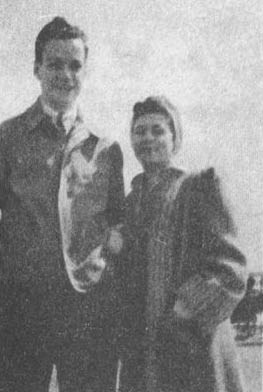
Richard and Arlene Feynman
You, dead, are so much better than anyone else alive.
– Richard Feynman, to his wife, Arlene
Richard Feynman is famous for his ceaseless questioning of life and the universe, to a degree unexpected even for being a Nobel Prize quantum physicist. His dogged investigation of the Challenger explosion is the most generally well-known demonstration of his mindset.
And then there was the time – while working on the atomic bomb at Los Alamos – when he got on all fours and put his nose on the carpet because he wouldn’t just accept at face value that bloodhounds had better senses of smell than do humans:
From his memoir, Surely You’re Joking, Mr. Feynman!:
(I’ve noticed that my dog can correctly tell which way I’ve gone in the house, especially if I’m barefoot, by smelling my footprints. So I tried to do that: I crawled around the rug on my hands and knees, sniffing, to see if I could tell the difference between where I walked and where I didn’t, and I found it impossible. So the dog is much better than I am.)
– Feynman, Richard P.; Ralph Leighton (2010-06-28). “Surely You’re Joking, Mr. Feynman!”: Adventures of a Curious Character (p. 105). Norton. Kindle Edition.
In his biography of Feynman, James Gleick writes that Feynman devoted his logical mind to plenty of non-quantum-physics hobbies, including teaching himself “how to play drums, give massages, to tell stories, to pick up women in bars…[and] he had no difficulty learning to make an impromptu xylophone by filling water glasses, nor had he any shyness about playing them, all evening, at a dinner party for an astonished Niels Bohr.”
However, Gleick writes, Feynman “despised philosophy as soft and unverifiable.” Philosophers, Feynman said, “are always on the outside making stupid remarks.”
But there are no atheists in foxholes, right?
We can’t be sure of what Feynman thought at his own deathbed. But we do know, through his biographers, a little of how his mind worked at the deathbed of Arlene, his first wife.
The two met as teenagers and had fallen so in love that Feynman promised to marry her after graduating from college. But Arlene fell ill and was eventually diagnosed with terminal tuberculosis and had just a few years to live. Feynman’s family tried to convince him that he should break his promise. They even brought the family doctor over to warn him of the dangers of contracting tuberculosis. Feynman responded, “Just tell me how it’s transmitted, and we’ll figure it out.”
Richard and Arlene (note: her name is also spelled “Arline” in the various biographies) decided that she should stay at hospital near Princeton and the couple got married on the drive there.
—
By June of 1945, Feynman was at Los Alamos working on the atomic bomb. His group was focused on measuring the energy output of the first (and only) trial of the bomb (July 16, 1945) before Hiroshima.
He was at work in the computing room when the call came from Albuquerque that Arline was dying. He had arranged to borrow Klaus Fuchs’s car. When he reached her room she was still. Her eyes barely followed him as he moved. He sat with her for hours, aware of the minutes passing on her clock, aware of something momentous that he could not quite feel. He heard her breaths stop and start, heard her efforts to swallow, and tried to think about the science of it, the individual cells starved of air, the heart unable to pump.
Finally he heard a last small breath, and a nurse came and said that Arline was dead. He leaned over to kiss her and made a mental note of the surprising scent of her hair, surprising because it was the same as always.
The nurse recorded the time of death, 9:21 P.M. He discovered, oddly, that the clock had halted at that moment—just the sort of mystical phenomenon that appealed to unscientific people.
Then an explanation occurred to him. He knew the clock was fragile, because he had repaired it several times, and he decided that the nurse must have stopped it by picking it up to check the time in the dim light.
Gleick, James (2011-02-22). Genius: The Life and Science of Richard Feynman (Kindle Locations 3604-3612).
At a moment when just about anybody would shove aside rational thought – even at least as a helpless reaction to mindnumbing grief – and favor that the universe’s chaos stopped just then to offer a sign of divine significance, Feynman instead sticks to cold hard logic, even if it means sterilizing the moment of his wife’s death. Some might find this application of scientific method off-putting. But maybe it was just an unavoidable feature of one of our most interesting and brilliant modern minds.
In his memoir, What Do You Care What Other People Think? (the title comes from Arlene badgering him over what Christmas cards to send), Feynman says upon kissing Arlene one last time, he was “surprised to discover that her hair smelled exactly the same” and, after thinking about it, thought “there was no reason why hair should smell different in such a short time.”
When asked the next day at the mortuary whether he would like to see Arlene one last time before she’s cremated, Feynman responds: “What kind of a – no, I don’t want to see her, no! I just saw her!” He instead packs Arlene’s things and heads back to Los Alamos:
I didn’t know how I was going to face all my friends at Los Alamos. I didn’t want people with long faces talking to me about the death of Arlene.
Somebody asked me what happened.
“She’s dead. And how’s the program going?†I said.
—
However, don’t assume that Feynman fit the maligned stereotype of the asocial, cold-hearted scientist. Read, well, any of his memoirs. Or read at least this letter he addressed to Arline, the year after her passing, unsent and undiscovered until his death in 1988 (Source Perfectly Reasonable Deviations from the Beaten Track: The Letters of Richard P. Feynman, h/t Letters of Note):
October 17, 1946
D’Arline,
I adore you, sweetheart.
I know how much you like to hear that — but I don’t only write it because you like it — I write it because it makes me warm all over inside to write it to you.
It is such a terribly long time since I last wrote to you — almost two years but I know you’ll excuse me because you understand how I am, stubborn and realistic; and I thought there was no sense to writing.
But now I know my darling wife that it is right to do what I have delayed in doing, and that I have done so much in the past. I want to tell you I love you. I want to love you. I always will love you.
I find it hard to understand in my mind what it means to love you after you are dead — but I still want to comfort and take care of you — and I want you to love me and care for me. I want to have problems to discuss with you — I want to do little projects with you. I never thought until just now that we can do that. What should we do. We started to learn to make clothes together — or learn Chinese — or getting a movie projector. Can’t I do something now? No. I am alone without you and you were the “idea-woman” and general instigator of all our wild adventures.
When you were sick you worried because you could not give me something that you wanted to and thought I needed. You needn’t have worried. Just as I told you then there was no real need because I loved you in so many ways so much. And now it is clearly even more true — you can give me nothing now yet I love you so that you stand in my way of loving anyone else — but I want you to stand there. You, dead, are so much better than anyone else alive.
I know you will assure me that I am foolish and that you want me to have full happiness and don’t want to be in my way. I’ll bet you are surprised that I don’t even have a girlfriend (except you, sweetheart) after two years. But you can’t help it, darling, nor can I — I don’t understand it, for I have met many girls and very nice ones and I don’t want to remain alone — but in two or three meetings they all seem ashes. You only are left to me. You are real.
My darling wife, I do adore you.
I love my wife. My wife is dead.
Rich.
PS Please excuse my not mailing this — but I don’t know your new address.
Note: A response on Hacker News prompted me to find out the circumstances of this letter’s publication. It is part of a collection released by his daughter, Michelle Feynman, and published in a ~500-page volume, Perfectly Reasonable Deviations from the Beaten Track: The Letters of Richard P. Feynman. I can’t recommend it enough, especially for the < $10 price tag.
As mentioned above, Richard’s letter to Arlene was unsent and undiscovered until his death. But it was not unread. In the volume, Michelle writes this preface to it:
This letter is well worn – much more so than others – and it appears as though he reread it often.
—

